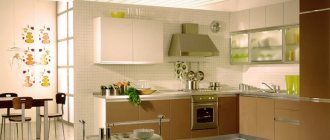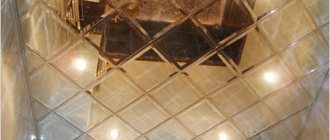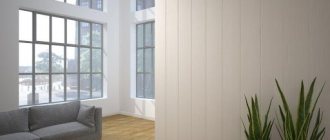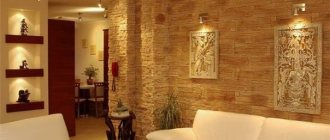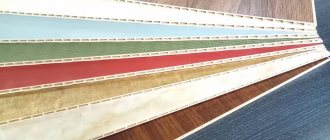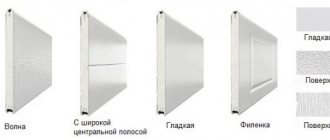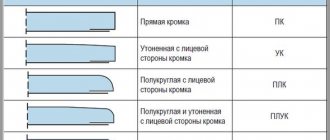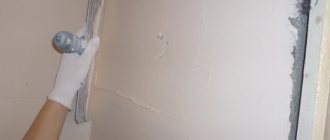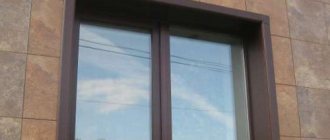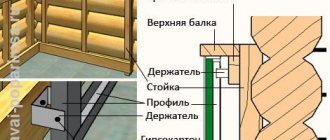Until recently, plastic for ceiling lining was used mainly in budget renovations of Soviet-built apartments. According to established tradition, these were an entrance hall, a corridor, a toilet, a bathroom, a kitchen, a balcony or a loggia. This was facilitated by the low price of the finishing material and easy maintenance - soot and grease were easily washed off with soapy water without streaks. Unpleasant odors and the simple design of plastic panels made such a ceiling inappropriate in living rooms: bedroom, nursery and living room.
Everything changed with the advent of new types of finishing materials made of polyvinyl chloride. Various colors, textures and sizes of panels, allowing you to create an interesting design for the upper part of the apartment, the ability to assemble a two-level ceiling and combine plastic finishing with gypsum plasterboard, decorative plaster and tension fabrics, the absence of odor, and ease of maintenance have made PVC panels in demand for people with average incomes .
The ceilings in all rooms began to be finished with plastic. The growing popularity of PVC did not pass by the owners of wooden houses - they increasingly began to cover their ceilings with polyvinyl chloride.
Advantages and disadvantages of ceilings made of PVC panels
The growing popularity of plastic ceilings is due, first of all, to their low cost and ease of installation. At the same time, this type of ceiling decoration has other advantages:
- the suspended structure allows you to hide all the defects of the ceiling: lack of horizontal, visible joints of floor slabs, peeling of concrete, microcracks, chips, sinks, etc.;
- communications can be hidden under the sheathing;
- the presence of free space between the ceiling and the floor slabs allows for additional insulation of the room and protection from the noise of neighbors above;
- it becomes possible to install spot lighting;
- lightness of design, which allows the use of “economy” profiles;
- no expensive finishing of the front side is required, unlike plasterboard;
- the panels are easily washed from dust, soot and volatile fats with detergents, after which their decorative qualities and color are completely restored;
- the material is resistant to changes in temperature and high humidity, is not afraid of domestic rodents and various small pests, which allows it to be used in damp and unheated rooms (dachas);
- non-destructive dismantling - the ceiling is disassembled and reassembled either in another room or in the same room, but after additional work has been carried out;
- the ability to install such a suspended ceiling yourself;
- durability - service life with proper care is at least 15 years;
- renovation of the finish is carried out only by replacing the panels - new sheathing is carried out on the old frame;
- environmentally friendly materials - the panels are made from the same material as disposable syringes.
Plastic ceilings also have disadvantages associated with the peculiarities of the finishing material:
- fragile - holes appear at the site of a minor pinpoint impact (they can be damaged by accidental finger pressure);
- under the influence of high temperatures, a lot of acrid smoke is released, harmful to humans;
- preservation of a specific odor for several weeks after installation;
- turn yellow (cloudy) when exposed to direct sunlight;
- melt when installing powerful lamps;
- limited design - creating something stylish and beautiful without using other types of finishing material is problematic;
- the presence of visible connecting seams, but this disadvantage is rather relative, because ideas emerged for turning seams into decorative elements.
Features of ceilings made of PVC panels
Plastic ceilings are of the suspended type with a rigid frame, where polyvinyl chloride is attached to wooden slats or metal profiles. PVC panels consist of two thin plates connected to each other at a distance of 5-10 mm from each other by stiffening ribs.
The presence of air space between the plates reduces the thermal conductivity of the ceiling and improves sound insulation. The panels have a tenon and a plate for fastening to the frame on one side, and a locking connection on the other.
Manufacturers guarantee a service life of at least 15 years in operating conditions from -50 to +50 degrees.
Tips: how to attach plastic panels to the ceiling on a frame made of wood and metal profiles
Modern plastic ceilings are not used exclusively in the bathroom, loggia or balcony; they are also found in other rooms.
Plastic panels made of PVC have many advantages compared to other types of materials for finishing ceilings. You can do the installation yourself. Let's figure out how to properly attach plastic panels to the ceiling. The chosen method depends on the room where they are installed, as well as on the quality of the requested surface. The parts are placed both lengthwise and crosswise, diagonally. The easy way is to attach PVC when placed along the length of the room, and the most labor-intensive and expensive way is to place it diagonally.
The required amount of material is determined by the area of the room. Dimensional parameters of PVC are indicated on the packaging.
Original interior design with plastic ceiling
Main types of panels
All types of commercially available panels can be classified according to several parameters.
Texture: glossy and matte.
By dyeing method:
- Plain, with increased UV resistance;
- Lacquered - in this way a glossy surface is created. A significant drawback is that the thinnest film of varnish is destroyed by any mechanical impact, resulting in a visible scratch;
- Laminated to look like natural materials. The main problem with such a ceiling is ultraviolet radiation. When exposed to sunlight, the laminate very soon begins to peel off;
- Mirror - a special film applied to the panel allows you to reflect up to 90% of the light. Such ceilings are installed in restaurants, large shopping centers, swimming pools, etc.;
- With printed design;
- With thermal printing, allowing you to diversify the color range of images.
By installation method:
- with visible seam;
- seamless.
The sizes of PVC panels can be:
- length - 270 cm, 300 cm, 400 cm, 600 cm;
- width - 10 cm, 20 cm, 25 cm;
- thickness - 10 mm.
Recommendations for choosing panels
Installation of PVC panels on the ceiling begins with the purchase of finishing material. Here you need to pay attention to quality and design. A quality product must have:
- smooth, wave-free edges, which will allow for quick and high-quality assembly;
- smooth surface, without protruding ribs;
- correct geometric shape (without twisting around the longitudinal axis);
- uniform coloring, with smooth color transitions;
- intact condition: no cracks or chips even on the back side.
The quality is also checked by a practical method: firmly squeeze the corner of the panel with your fingers several times. Bad material will break, good material will be slightly deformed. You should not skimp on the thickness of the plates (all PVC panels are 10 mm thick, but they may have front and back plates of different thicknesses) - you should avoid buying thin ones.
Finishing the ceiling with plastic panels should not be based on the personal preferences of the master or owners when choosing a design. Here are the fundamental principles that should be followed:
- The light color of the panels will visually expand the space;
- The glossy surface creates the illusion of a distant ceiling;
- There should be no more than 3 colors in the room, including the floor, walls and ceiling. Black and white colors are not taken into account, they are neutral (does not apply to drawings and images printed on the ceiling);
- When panels are painted monochrome, there should not be more than 2 colors at the top, including white;
- Visible seams should be avoided if they do not serve a decorative function.
The choice of panel manufacturer also influences the consumer properties of the ceiling - there are many of them on the Russian building materials market. Among the best:
- Venta (Belgium). It produces PVC panels of various sizes and designs, including those with patterns applied by modern digital printing machines. Products of the upper price segment.
- Forte (Italy). On the market since 1969. High quality products with a huge number of colors and shades, allowing you to create an interesting design in any room of the apartment. The cost of the panels corresponds to the quality - high.
- LLC "Planet Plastic" (Russia, Moscow). It works on foreign equipment and completely imported raw materials. The product range includes more than 150 options for finishing panels.
- AnV-plast LLC (Russia, Krasnodar). A young but rapidly progressing company. Works entirely on domestic raw materials. Wins the competition thanks to a wide selection of panels both in size and design, as well as a lower price.
Preparatory stages for assembling a ceiling from PVC panels
The ceiling made of plastic panels is assembled with your own hands in a strict order of work performed. First comes the preparatory work:
- the amount of materials is calculated;
- ceiling panels, metal profiles, moldings and screws are purchased, a set of necessary tools and fixtures is completed;
- The ceiling surface is being prepared for installation of the frame.
Calculation of the required amount of materials
Before calculating the required amount of materials, you should decide on the direction of laying the panels. The rule applies here: the connecting seams must be parallel to the flow of light, i.e. perpendicular to the window. However, if the distance between the wall with the window and the opposite wall is more than 6 m, you will have to choose between an additional connecting seam between the panels along the length and installation of PVC parallel to the window. Many people choose the second option.
The method for calculating the number of panels differs from the generally accepted scheme for calculating the material covering any surface. The option when the total area of the ceiling is determined, and then based on this indicator the amount of material required is not suitable. In our case, we first measure the length of the wall parallel to which the panels will be laid.
The result obtained is rounded up to the nearest whole number in order to know what length of panels you need to buy. Then the length of the adjacent wall is found, which is divided by the width of the panels planned for installation. The result obtained is multiplied by 1.1 to compensate for unexpected losses of material during installation. When buying PVC, you need to consider one more point: there are always 6 panels in a package, regardless of their size.
To demonstrate what has been said, we will carry out all the calculations for a real room. Initial data:
- the length of the wall with the window (we denote the wall with the symbol A, the opposite one with the symbol A1) - 3.8 m;
- the length of the adjacent wall (B) and the wall opposite it (B1) is 5.6 m;
- panel width - 0.25 m.
Thanks to simple calculations, we determine the number of panels: 3.8 / 0.25 x 1.1 / 6 = 2.7 (3 packs of 6-meter panels).
The number of guide profile (PN) is determined by the formula: H = L x 2 / 3 , where:
- H—number of profiles, pcs.;
- L—length of wall B, m;
- 2 - number of walls;
- 3 - standard length of the guide profile, m.
We substitute the numbers: 5.6 m x 2 / 3 m = 3.7 . The result is rounded up to the nearest whole number. Thus, it is necessary to buy 4 PN profiles.
The number of ceiling profiles (PS) is calculated as follows: K = L / C x M , where:
- K is the length of the ceiling profile in m;
- L is the length of wall B;
- C - step length between the ceiling profile, m;
- M - length of wall A, m.
We calculate the number of PS profile: 5.6 m / 0.4 m x 3.8 m = 53.2 m . In order not to connect profiles along the length, you need to buy 4-meter ones - 14 pieces are required for work. (53.2/4).
For reference: profiles with lengths of 2.5 m, 3.0 m, 3.5 m, 4 m are offered for sale.
The number of ceiling plinths (moldings) is calculated simply: S - equal to the perimeter of the walls (5.6 m x 2 + 3.8 m x 2).
Required materials and tools
Installation of plastic panels on the ceiling will require the purchase of the following materials:
- panels made of polyvinyl chloride - 3 packs;
- plastic moldings (plinth, baguette);
- profile PN (guide) 25x25x3000 (economy) - 4 pcs.;
- PS profile (ceiling) 60x25x3000 (economy) - 14 pcs.;
- direct suspension;
- dowel-nails 6×60;
- self-tapping screws “bug”;
- self-tapping screws with a press washer;
- liquid nails;
- electrical wires;
- lamps.
In order not to be distracted while searching for the necessary tools during work, you should prepare in advance:
- stepladder or scaffolding (popular name “goats”);
- hammer drill with attachments;
- screwdriver;
- “Grinder” (if necessary, replace a hacksaw with a blade for metal);
- laser or hydraulic level;
- roulette;
- construction angle (90 degrees);
- knife with replaceable blade;
- construction (beating) cord.
Preparatory work
A plastic ceiling has two problems:
- under a certain lighting angle, everything that falls on the ceiling surface from the floor panels can be seen through the plastic;
- Small debris falling from the concrete floor leaks through the connecting seams.
You can prevent such moments very simply - clean the ceiling with a wire brush and then wipe with a damp cloth. It is advisable to fill small cracks and chips.
At the end of the preparatory work, many professionals advise treating the floors with a deep penetration primer with antifungal agents. This operation will prevent the appearance of mold and fungi in the corners.
Materials have been purchased, a set of tools has been prepared, and the ceiling has been cleaned. All that remains is to find out how to make a ceiling from plastic panels with your own hands.
How to attach PVC panels to the ceiling
Important At the planning stage, it will not be superfluous to mark the lines along which you will cut the profile of the frame and PVC panels. At the same time, you can make marks on them using a pencil and marker, indicating in what order they should be laid. The second point of preparation is the removal of old finishing materials .
If the ceiling was previously covered with a thick layer of plaster or paint, then all this must be removed, otherwise heavy pieces of old finishing can damage the frame or the panels themselves.
In addition to the PVC sheets themselves, you will need to purchase an installation profile. It consists of two “shelves”, one of which is attached to the frame, and the other is connected to plastic panels. Both the starting and finishing PVC sheets are attached to the installation profile . When choosing it, you should pay attention to the thickness of the plastic and whether the profile has any bends or defects.
Next, you should begin installing the electrical wiring (if you plan to make ceiling lights). It is advisable to place it in a corrugated plastic sleeve, which will protect the wiring from moisture. PVC panels are a finishing material made from polyvinyl chloride, a plastic that does not burn well and is chemical resistant. Now let's look at the design of PVC panels. There are many types of polymer glue on the construction market and each of them is good, although made by a different manufacturer.
But most finishers prefer two options: liquid nails or PVA - this is not only cheaper, but also more convenient. Moreover, it is equally suitable for both MDF and vinyl. If the length of the rad turns out to be greater than the length of the CD, then they will have to be joined and connectors are used for this, although this is not necessary. Instead of connectors, the profile is simply cut and joined, secured with small self-tapping screws. But here it is very important that the joining point falls exactly on the bracket; therefore, the profile may have to be cut in order to correctly calculate the fastening of the two parts.
You can attach plastic panels to drywall using liquid nails. The adhesive composition must be applied to the back side of the canvas in the middle, as well as along the perimeter. When the mixture is well absorbed, the canvas must be glued to the base, pressing firmly.
Then install it in the groove of the last “start” and slide it into the groove of the penultimate panel.
There is no need for subsequent fastening. In places where it is planned to install lampshades or chandeliers, additional sheathing is installed in advance. PVC panels make it easy and simple to cover walls and ceilings in any room.
At the same time, you do not need to worry about the costly leveling of the base of the wall or worry about the exorbitant cost of installation work. Making the same suspended ceiling with your own hands using PVC panels will not be difficult, even without many years of experience in repair work.
Installation instructions
Installation work has a step-by-step algorithm for performing technological operations:
- a diagram of fastening the frame and lamps (if necessary, and drivers) is drawn up;
- marking of the passage of the guide and ceiling profiles, places of fastening of direct suspensions and lamps is carried out;
- the PN guide profile is attached to the wall;
- the frame is assembled;
- wires are routed for lighting;
- panel ceiling is installed;
- finishing work is being carried out.
Drawing up a diagram and marking
Many builders ignore the process of drawing up diagrams and markings. In principle, you can install a plastic ceiling without them. It will just take a few hours longer. After all, thanks to a simple drawing, you can first mark on paper, and then on the walls and ceiling, the locations of lamps, pendants and profiles with centimeter accuracy.
Marking.
Work begins by finding the lowest point of the ceiling. To do this, it is enough to measure the height of the apartment in the corners (ceilings have a flat surface, so a large number of measurements, as when screeding a floor, are not required).
At the next stage, the inter-ceiling space required for the lamps is determined (you need to know in advance which lamps will be installed). From the lowest point of the ceiling, you need to go down the distance required by the light sources and fix the future ceiling plane on the wall. Using a hydro- or laser level, a line is drawn along the entire perimeter of the room on the wall along which the panels will be assembled. If the correct calculation was made, the ends of the line will coincide. If the discrepancy is 0.5 cm or more, the work must be redone.
The rest is simple: use a tape measure to mark the mounting points of the ceiling profile (40 cm increments), suspensions (70 cm increments) and the location of the lamps. The work is not difficult, but it saves a lot of time.
Profile fastening
Fastening the frame begins with installing a guide profile on the wall. Step by step it looks like this:
- the metal guide is cut with a grinder or a hacksaw to the size of walls B and B1;
- in the profile, holes for self-tapping screws are drilled with a puncher - the first and last 10-20 cm from the edge, the rest in increments of 50 cm;
- the plank is pressed tightly against the wall with its lower part strictly along the line of the ceiling;
- Marks for hardware are made through drilled holes on the wall;
- holes are drilled and dowels are driven into them;
- the PN profile is attached to the wall with self-tapping screws so that there are no gaps.
For reference: some sources claim that if there is an urgent need not to lower the ceiling low, guide panels can be fixed to the wall with liquid nails. Then the height of the apartment will decrease by only 3.1 cm. This technological solution can be used, but with the condition that the supporting profile will be attached to the ceiling every 40 cm. Another solution to the problem is to hem plastic panels onto a wooden sheathing or MDF sheets.
Frame installation
The structure of the frame for suspended ceilings is discussed in detail in the work “Do-it-yourself suspended ceiling made of plasterboard.” Let us briefly recall the instructions:
- Direct suspensions are attached to the ceiling;
- the PS profile is cut to size using a grinder or a hacksaw;
- both ends are inserted into the guide profile and secured with “bug” self-tapping screws;
- The supporting strips are additionally attached to the ceiling with suspensions - one “bug” on each side.
Attention: the PS profile must be inserted into the guide bar strictly perpendicularly.
After assembling the frame, hangers are attached to the installation site of the lamps.
Laying wiring
An important point in installing a suspended ceiling made of plastic panels is the wiring for lighting. It begins after installation of the frame. There are several points to consider here:
1. When laying wiring under a voltage of 220 V, it must:
- have a double braid;
- hide in a plastic corrugated tube;
- do not sag (should not touch future panels);
- accurately reach the place where the lamp is mounted;
- be fixed from the frame at a distance of at least 2 cm;
- have sufficient ends to connect to lighting fixtures.
2. Wires for voltage 12-24 V at first glance are very easy to connect to each lamp. However, there are a number of important points here:
- The wiring length for LED lamps cannot be more than 2 m - they sharply lose luminous flux power. Therefore, it is necessary to provide for the installation of several drivers on the ceiling.
- If possible, connect wires into bundles using plastic clamps.
- Avoid contact with 220 V wiring.
Frame assembly
Naturally, before you begin assembling and installing the base, you must first purchase everything you need and prepare the tools.
Depending on the chosen mounting option, you can use either a special starting plastic profile, or use an aluminum one, but then you will also have to buy a decorative plinth that will disguise the junction of the wall and the ceiling.
Any of the selected options involves attaching the first parts of the future foundation to the walls, according to the applied markings.
This will be a kind of frame for the frame. Transverse structural elements are inserted into the fixed profile. They are additionally attached to the ceiling slab using special hangers.
The distance between the transverse elements is usually 50 - 60 centimeters.
All of them are mounted so that they are subsequently directed perpendicular to the decorative coating. The parts installed in the base are fixed using metal screws. The assembled frame should be located strictly in a horizontal plane and look approximately like the photo above.
If the room is small, and the covering strips are supposed to be installed across, and not along the length of the room, then you can use a plastic starting profile, which combines the functions of fasteners and decorative plinths, or use a regular profile without decor.
This element will bear the entire load, and the ceiling parts will not be attached to anything else in this case. You can choose this option only when the distance from the beginning of the decorative strip to its end is not too large, otherwise it will simply fall out of the profile or bend greatly in the middle.
In addition, a structure obtained only with the help of such fasteners will not be very strong, therefore, it is better to make a full-fledged frame from aluminum parts, and use these profiles for their intended purpose - for subsequent decoration of the joints of the ceiling and wall.
Panel installation
The owner of the house can install the plastic ceiling himself. The only thing he needs is installation technology and the help of one of the family members (a long panel cannot be held alone). Any beginner in the construction business will understand the instructions on how to attach plastic panels to the ceiling.
1. Along three walls (A, B and A1), close to the guide profile, a ceiling plinth with a groove for PVC panels is attached to the wall using liquid nails.
2. Using a tape measure, measure the distance between walls A and A1 for the first panel.
Important: there are practically no right angles in the apartments. Therefore, the length of adjacent walls may differ by several centimeters, which requires measuring the distance between the walls for each PVC strip.
3. The panel is cut 5 mm shorter on each side. The tool is a hacksaw or grinder.
Attention: for panels up to 3 m long, you need to cut 1 cm off each side, otherwise you won’t be able to insert it into the plinth - it will break if it bends.
4. The film is removed from the panel (protection is not installed by all manufacturers), after which it is oriented so that the lock is facing the wall, the tenon is facing out, and the fastening strip is on top. One end is inserted into the groove of the ceiling plinth. The plank is slightly bent downwards, after which the second end of the panel is inserted into the groove.
Important: before starting work, it is necessary to pre-lay out all panels. This operation is necessary in order to correctly determine the size of the last bar. If it turns out to be less than 1/3 of its width, the first panel must be cut - 1/3 of the width is cut out.
5. We bring the plastic into a horizontal position and carefully push it into the ceiling plinth on wall B. To ensure that the panel is easily inserted, we help with a small thin spatula. Problems may arise due to slight deformation of the panel lock. Therefore, you need to work with a spatula not only from below, but also from above. Since all connecting nodes are standard, the plastic will always fit into the groove exactly.
6. The panel is attached with self-tapping screws to the ceiling profile. The operation is simple, but not everyone knows how to attach PVC panels to the ceiling correctly. If you screw a self-tapping screw directly into the mounting strip, the screwdriver often tears the bit off the head of the hardware and damages the plastic. Experienced professionals screw in the hardware with the press washer next to the bar. The panel is not clamped by the screw itself, but by the edge of the washer. This technology eliminates damage to an already installed ceiling.
For reference: some experts, in order to avoid damaging the panel, first drill a hole and then screw in a self-tapping screw. But it's a waste of time.
7. The next panel is mounted, up to the last strip. We will tell you how to install the last panel separately.
How to install the latest panel
Installing the last panel is the most difficult operation in the entire plastic ceiling assembly technology. There are several installation methods. Let's consider the simplest one. The work is performed in the following sequence:
- The distance from the wall to the penultimate panel is measured in different corners - it can vary by several centimeters;
- 1 cm is subtracted from the results obtained;
- The width of the panel is adjusted to the required size using a hacksaw or grinder;
- The panel is inserted at both ends into the grooves of the plinth;
- Using tape and a spatula, the strip is snapped into the lock of the previous panel;
- Spacers are placed between the wall and the last PVC so that the panel does not move into the groove of the plinth - it will not be possible to fix its position with self-tapping screws;
- The plinth is cut out for spacers, smeared with glue and inserted between the wall and the panel, after which it is pressed against the wall. After 10 minutes, you need to press it against the wall again;
- Use a rag to wipe off excess glue.
Frame installation
The main stage, which requires time and effort, is the installation of the mounting frame. It further determines the overall appearance, quality of installation and horizontal placement of the panel covering. Useful ideas can be gleaned from the video.
On leveled ceilings, installation of the frame is not required, unless the installation of built-in lamps is provided; the plastic is secured by gluing. In rooms with normal humidity, specialized glue will be required, and in rooms with high humidity it is preferable to use liquid nails.
If the surface of the ceilings is uneven, then a frame is necessary. The following nuances are taken into account:
- bars or metal profiles on which panels made of PVC are attached are placed perpendicular to the direction of their installation;
- if built-in lamps are supposed to be installed inside the mounted frame, then a gap of 10 to 12 centimeters is left from the ceiling to them;
- Before installing the frame, determine the lowest angle in the room by measuring it with a tape measure from floor to ceiling. The lowest point is the main height when installing PVC. From it, a horizontal contour is marked around the perimeter of the room for further installation of the frame;
- In order to increase the level of moisture resistance, the gaps between the bars are sealed using silicone sealant or a vapor barrier material is attached to the ceiling area.
Installation of the frame is the main stage, since the quality of the ceiling is directly dependent on whether it is mounted correctly and whether the fastening is carried out correctly.
Installation of plastic panels on a wooden frame
In rooms with normal humidity, where there are no drafts, slats or blocks of wood are used for the frame under the ceiling. They cost less than metal profiles, and the work is easier to do with them. The video will help you master the proper creation of a wooden frame and fastening of plastic panels.
Important! For the bars you will need dried wood, which is treated with a specialized antiseptic.
Features of fastening the frame and plastic panels to the wood sheathing are as follows:
- the maximum distance in such a sheathing between beams or slats is 30-40 cm.
- when attaching the frame to a wooden ceiling, self-tapping screws are used, and if the base is concrete, dowels are used;
- When installing the sheathing, the horizontality of the bars is adjusted using pieces of wood.
Advice! To simplify the installation of PVC, string is pulled and guided along it.
- The installation of plastic elements begins with a starting profile in the form of a plinth; it has a recess that runs along its entire length. A panel is inserted into it, and the side with the groove is attached to the sheathing using nails, screws or staples.
- further installation work is carried out in a similar order until the very end of the surface. Upon completion of the installation of the panels, the finishing corner is attached and the panel is inserted into it, but it is not secured.
Important! Upon completion of the installation work, a ceiling plinth is attached around the perimeter, which closes the gap between the installed panels and the wall - this gives the appearance of the room completeness.
Installation of plastic panels on a metal profile frame
In those rooms where the humidity is high or there are drafts, a metal profile is used under plastic panels. L and UD type profiles (ceiling) are fixed around the perimeter of the room. For those planks that are located across the ceiling, CD is used.
Metal profile installation steps:
- a metal profile is attached to the ceiling using self-tapping screws;
- then, along the perimeter of the room, along a pre-prepared contour, a UD profile is fixed using dowels so that there are no gaps left;
Important! Do not forget to check the horizontal level of the structure - this will ensure good quality of installation, otherwise the ceiling will turn out crooked.
- then the CD transverse profile is attached to the ceiling surface;
- then, along the perimeter of the room, an L-shaped plastic profile is attached to the mounting profile;
- then the required length of the panel is measured and sawed off with a hacksaw designed for working with metal elements.
- the first panel is inserted without gaps into the L-shaped profile, and then it is secured with self-tapping screws.
- the remaining panels are fastened to one another using the tongue-and-groove method, and to the transverse profile using fasteners.
Important! If necessary, the final panel is cut to the required size with a metal knife.
Upon completion of the installation of the panel plane, a finishing corner is installed, which fixes the final panel in the row. Then, as with fastening to a wooden sheathing, a ceiling plinth is installed around the perimeter.
The final result of fastening
Advice! When fastening, make sure that the plastic is laid evenly and that there are no gaps left; periodically check the horizontal position using a level.
After carefully studying the steps of installing the frame and attaching the plastic panels, you will be able to handle this work yourself.
Video tips for installing the frame and attaching plastic parts to the ceiling:
Finishing
Once the ceiling is assembled, there is one final, but very important, touch left—beautification. There are several operations that are independent of each other.
1. In this work, we considered the option of installing PVC panels directly into the ceiling plinth with a groove for the ceiling. In this case, no additional operations are provided. If a collapsible version of the molding was used, then a baguette must be glued to the U-shaped profile. Glue (liquid nails) is applied only to one side of the plinth: from the wall or profile and from the ceiling.
2. An internal angle is never right. Therefore, it is impossible to perfectly adjust the corner connection of the plinth strips. You can remove the gap with acrylic putty of the appropriate color.
3. For various reasons, gaps often form between the installed ceiling and the plinth (the panel inside the guide profile is pinched, a sag that is invisible to the eye has formed, etc.), which does not enhance the work done. You can fill the gap with an acrylic-based sealant (in a tube) inserted into a construction gun.
The sealant is pumped into the gaps in small portions, no more than 30 cm in one pass, after which the excess acrylic is removed with a narrow spatula with a sharp blade. Use a damp sponge to remove traces of putty from the ceiling and baseboard. If this is not done in a timely manner, the sealant will set and cannot be removed. This goes along the entire perimeter of the ceiling.
4. As noted above, it is better to install lamps as the ceiling is assembled. If this work is not done in a timely manner, then the holes for the light sources must be made with an electric drill with a crown. In size, it should be 4 mm larger in diameter than the lamp itself. After this, the lighting device is connected to electrical wires and fixed to the ceiling.
Installing plastic panels on the ceiling: various mounting methods
When planning to install plastic panels on the ceiling, you must evaluate their shortcomings so that they do not come as a complete surprise to you. They exist, and if you do not take into account all the nuances, you can later severely repent.
It doesn’t hurt to also sort out the choice of panels so that they best suit your desires and goals.
To do this, you need to consider a few simple tips that are not at all difficult to remember.
The main factor that attracts consumers is the revolutionary low cost of this finishing material with an excellent appearance. When compared with suspended ceilings or plasterboard, PVC boards compare very favorably. The video below will tell you best about how to attach plastic panels to the ceiling, but it won’t hurt to understand the process step by step and in different options.
There are several fairly simple methods on how to proceed to achieve the best result, which is what we will tell you, but you should start with the selection of materials and tools, since it is impossible to do without special devices, as was described above. Before you begin to thoroughly figure out how to attach plastic panels to the ceiling, you need to understand why you should choose this particular material for decorating your home or whether it is better to abandon it altogether. The wide relevance of PVC panels in recent years proves the advisability of purchasing them for ceiling cladding in various rooms, but it does not hurt to understand this issue in more detail.

